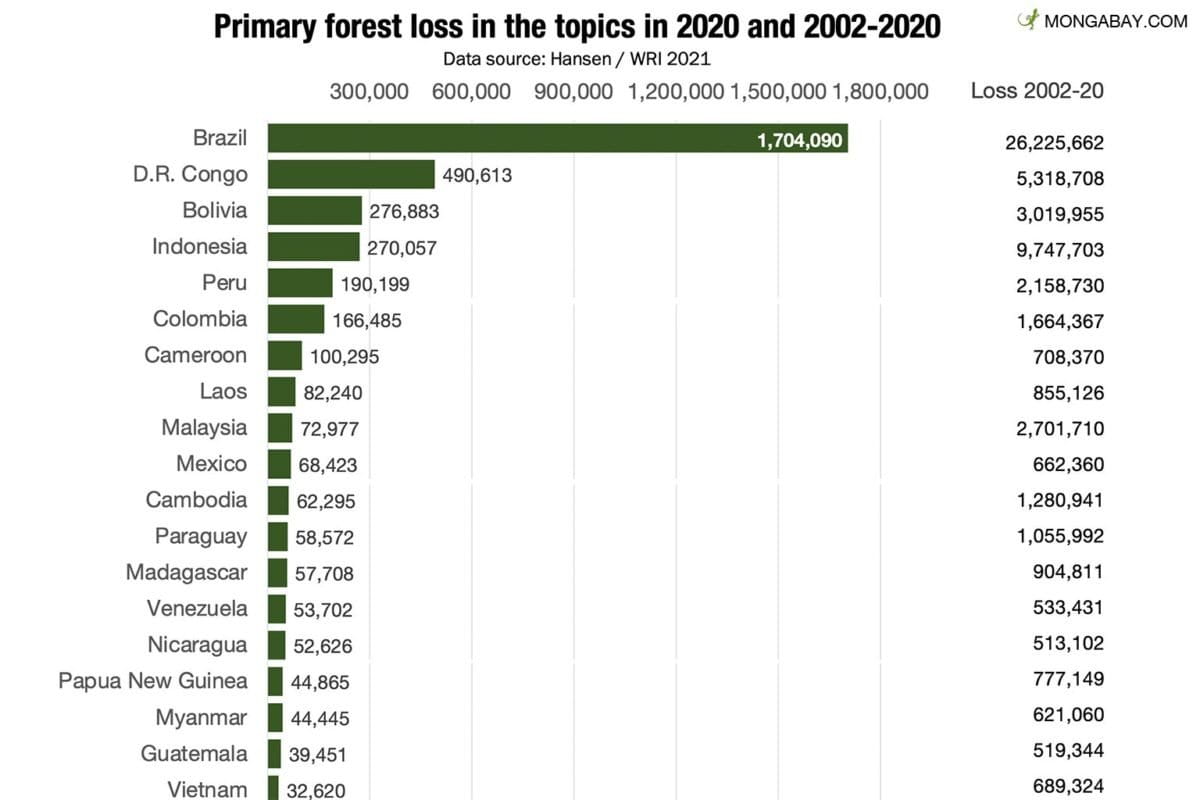- After Brazil, the South American country that lost the greatest area of primary forest over the past twenty years is Bolivia. The past few years, the land-locked nation has experienced vast forest fires that have affected millions of hectares.
- In response to this trend, in 2017 a group of citizens led by Gina Méndez, established an NGO called the El Llamado del Bosque and launched a campaign on behalf of Bolivia’s forests, wildlife, and forest-dependent communities
- Méndez, who previously served as mayor of Bolivia’s largest city, a member of the national congress, and the country’s Minister of Justice and Human Rights, says she was moved to start the movement by the “heartbreaking” loss of forests.
- Méndez spoke about her work, the challenges facing grassroots conservation in Bolivia, and more during a recent interview with Mongabay founder Rhett A. Butler.
After Brazil, the South American country that lost the greatest area of primary forest over the past twenty years is Bolivia. The land-locked nation has seen its diverse forests rapidly shrink despite a much-publicized law to protect the rights of Mother Earth and political proclamations to safeguard the interests of Indigenous communities. Bolivia’s forests have been disappearing largely due to a combination of industrial agriculture, including soy and cattle farms, and increasingly severe incidence of fires.

In response to this trend, in 2017 a group of citizens led by Gina Méndez, a former member of Bolivia’s national congress and the former mayor of Santa Cruz, Bolivia’s largest city, established El Llamado del Bosque, an organization that advocates on behalf of Bolivia’s forests, wildlife, and forest-dependent communities. El Llamado del Bosque set forth its call to action in the campaign called the “El Pacto del Bosque” (“Forest Pact”), which was signed by 100 Bolivian leaders from a wide swathe of society.
“The idea that nature could vanish in the blink of an eye is what inspired me to get involved in the search for more immediate solutions,” Méndez, who also previously served as Bolivia’s Minister of Justice and Human Rights, told Mongabay. “I decided the problem required a common effort, which led to the idea of founding a citizen’s platform to contribute to the conservation of Bolivia’s forests.”

Since the Forest Pact was established, more than 500 individuals, institutions, and organizations have joined the movement. El Llamado del Bosque has coordinated protests, environmental education initiatives, eco-festivals, and forest restoration drives in areas affected by fires.
Gina Méndez spoke about these advocacy efforts, the challenges facing grassroots conservation in Bolivia, and more during a recent interview with Mongabay founder Rhett A. Butler.
This interview has been lightly edited for clarity.
An interview with Gina Méndez
Mongabay: What originally inspired your interest in wildlife and conservation?
Gina Méndez: I was born and raised in the Department of Santa Cruz, which has become the epicenter of deforestation in Bolivia. The loss of our incredible forests at a rate of up to 400,000 hectares a year was heartbreaking for me.

The idea that nature could vanish in the blink of an eye is what inspired me to get involved in the search for more immediate solutions. I decided the problem required a common effort, which led to the idea of founding a citizen’s platform to contribute to the conservation of Bolivia’s forests.
Mongabay: How did your career path unfold?
Gina Méndez: Before I was a lawyer, then the mayor of my city, then a member of parliament, and finally, I was a minister.
But I felt like my life restarted when my career path shifted into becoming a full-time environmental activist.
In 2017 I heard a personal call; in Spanish, “call” is “llamado”. That is why the movement/organization I founded is called “El Llamado del Bosque” (The Call of the Forests).
I felt it was time to move past my 15-year career in public administration and join the efforts of the relentless community of environmental organizations that I’ve long admired for their arduous commitment and tireless work on conservation issues.
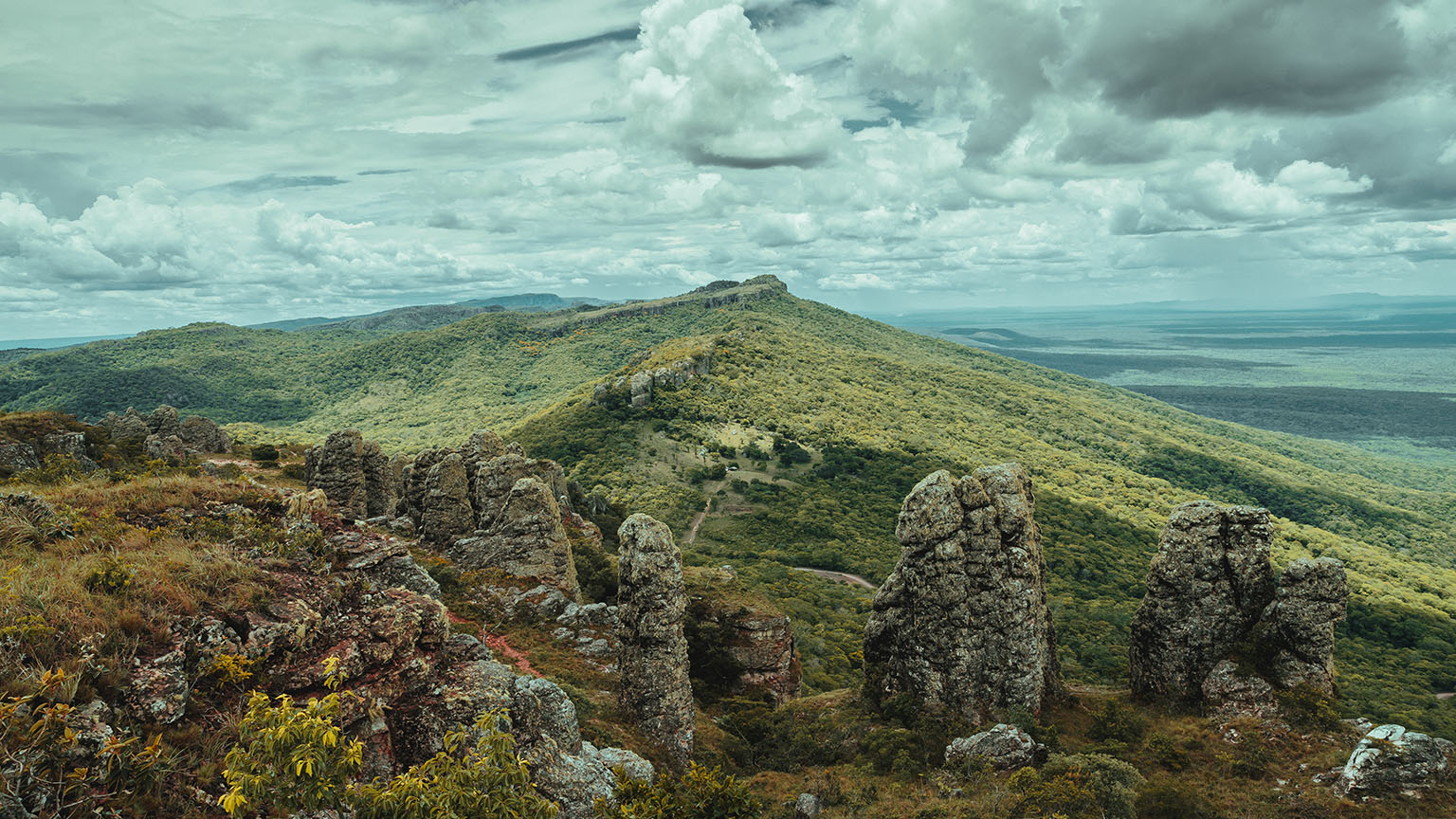
Mongabay: What is the focus of your work?
Gina Méndez: These past few years El Llamado del Bosque has achieved:
(1) A petition addressed to leaders from all over Bolivia—artists, Indigenous, academics, media, government etc—to sign to place greater pressure on the national government to stop deforestation;
(2) An ecotourism festival;
(3) A project to support the communities ravaged by the forest fires: Sowing Hope – Forest Joint Ventures; and
(4) An educational program designed to create ‘school forests’ to provide environmental sustainability educational resources.
In 2019, El Llamado del Bosque created a forest ecotourism festival as a tool to draw attention on the need to educate and conserve Bolivia’s endemic flora and fauna species that are in great danger of extinction. A spectacled bear, a spider monkey, a stone-topped turkey and a jaguar were the central characters. The event successfully conveyed the conservation message to the public.
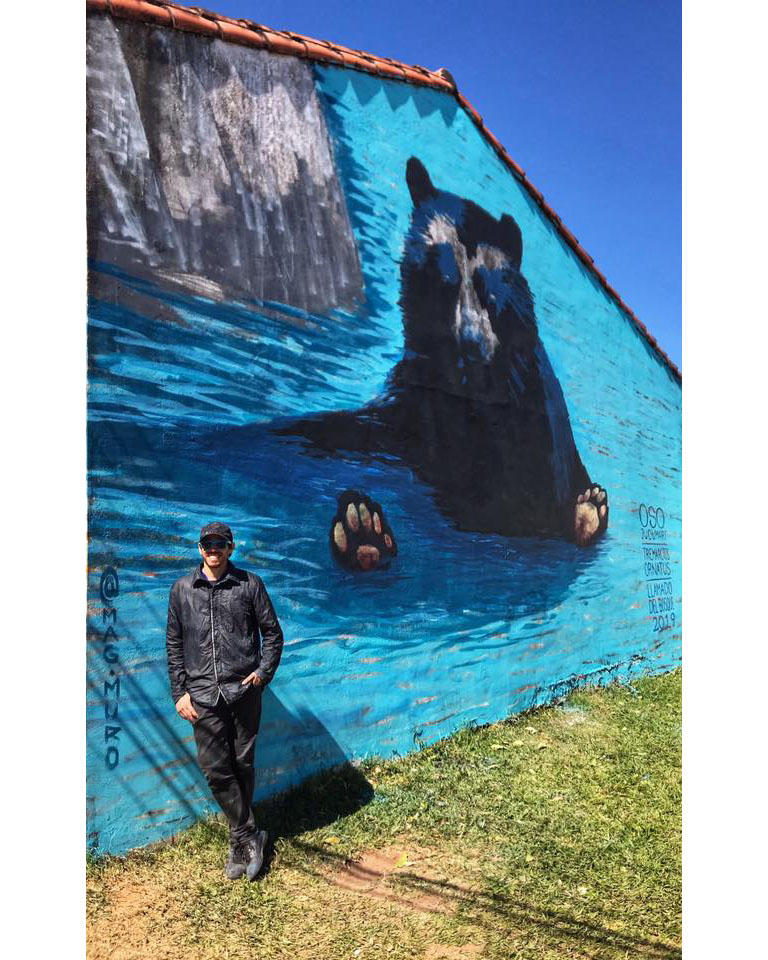
After the forest fires of 2019 and 2020 that devastated more than 2 million hectares of the Chiquitano Dry forest, we felt the need to take an active role in restoring forests. The fires were not yet extinguished when we got to work with local and international volunteers from Alas Chiquitanas, Gaia Pacha and Action for Bolivia. We worked together to restore areas burned by the fires and empower local peoples as guardians of the forests. We took soil samples and prepared the parcels for replanting.
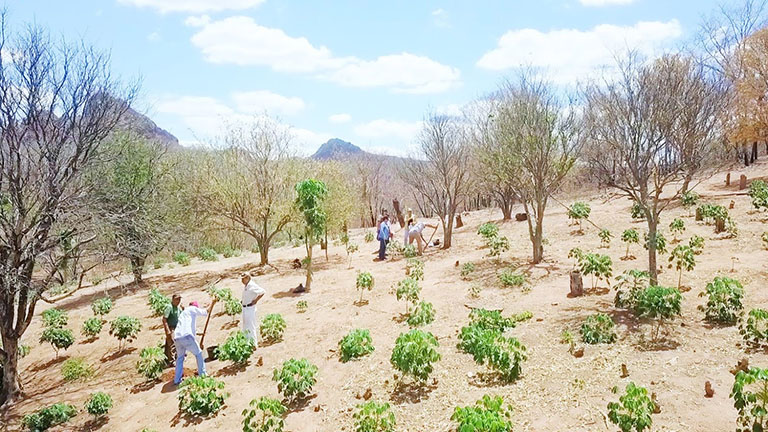
In 2020 the pandemic stopped our field activities for a year; However, we reinvented ourselves as a digital platform to help women with the “Forest Joint Venture” initiative, in alliance with Creative Market enterprise, and thus we were able to sell handicrafts, ecological products, and natural medicine made by women from the communities.

In 2021 we joined as founding members of the Bolivian Inter-Institutional Ecological Restoration Network (RIREB) to continue our restoration work and our project, Sowing Hope Phase II, in alliance with other organizations.
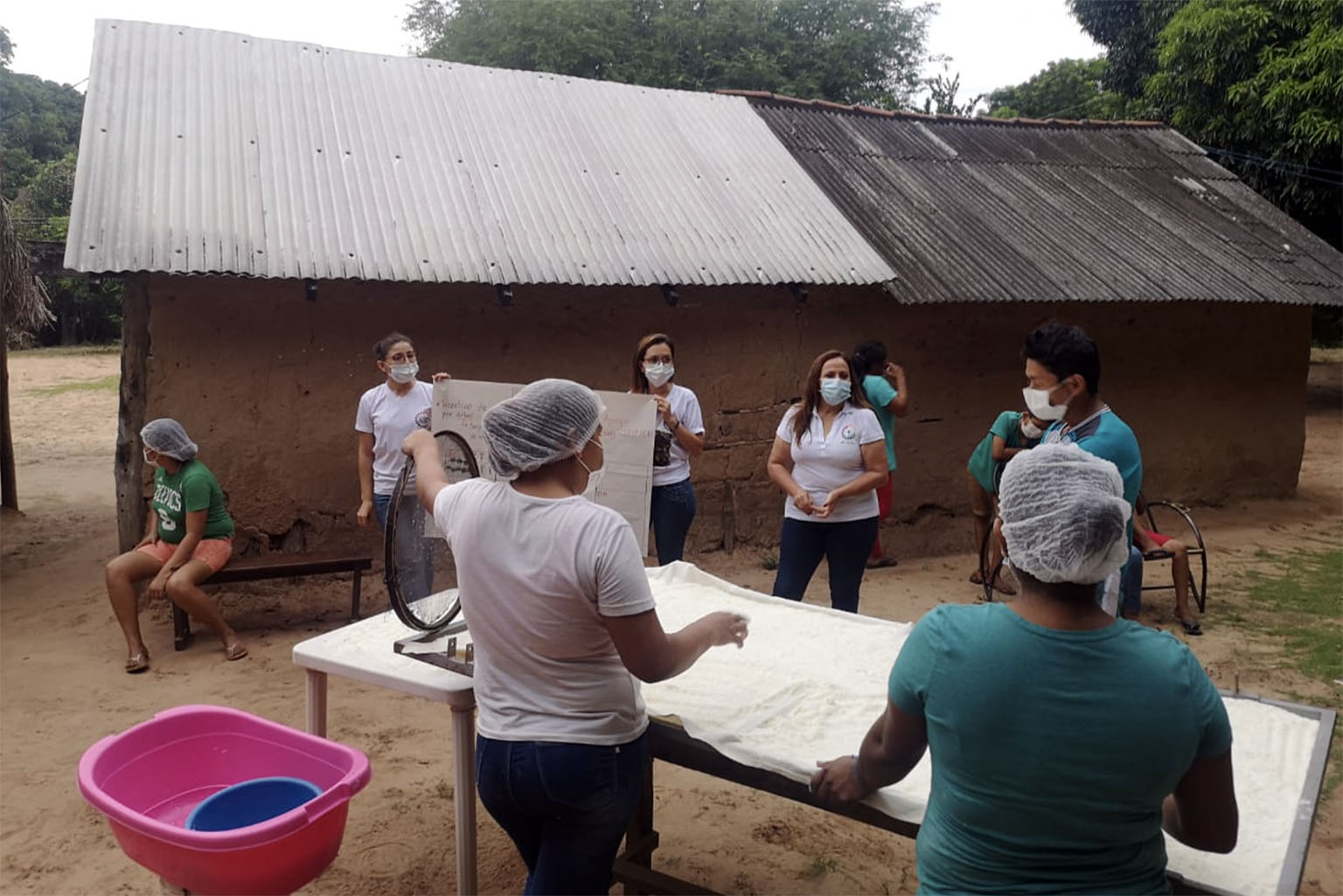
On the education side, we are moving towards the implementation of ‘school forests’ with the aim to educate and inspire children and young people to protect nature and wildlife.
As we continue with our projects in rural communities ravaged by the fires, we are now preparing to move into a new role in line with our mission, which is to build alliances and partnerships to advocate for comprehensive and lasting solutions to deforestation in Bolivia.
Mongabay: Relative to Brazil, Peru, and Colombia, it seems like the forests of Bolivia are often overlooked internationally. Do you have a sense of why this is the case?
Gina Méndez: Maybe size? Bolivia has less exposure to international media especially in relation to deforestation. Most of the attention is focused on Brazil, perhaps because of its enormous land area. Bolivia’s high rate of deforestation is dwarfed by levels in Brazil.
Geographically we might be a smaller territory – but proportionally there is a larger percentage of forest areas being devastated! For example, last year Bolivia ranked third in the world in terms of primary forest loss, according to Global Forest Watch. Bolivia’s primary forest loss was greater than Indonesia, where huge areas of forests are being cut down for palm oil.
It could be that the environmental disaster in Bolivia is not getting much media attention because of the crisis unfolding in Brazil. Or maybe we rarely receive any coverage because of the success of the greenwashing campaign by Evo Morales. The former president for years talked about the protection of the Pachamama, diverting attention from the burning forests and ecosystems that were being destroyed for industrial agriculture.
Ultimately, it’s probably a combination of these factors that make Bolivia overlooked.
Mongabay: What is the biggest challenge to addressing deforestation in Bolivia?
Gina Méndez: It is necessary to find more sustainable ways of production in Bolivia without destroying our natural heritage. We must shift our agricultural methods and markets towards more sustainable approaches, which include seeking international markets specially for agricultural commodities like soy and beef produced without deforestation.

The biggest challenge is getting industry and government players to sit down together and agree to a clear plan with time-bound implementation policies to end deforestation for soy and beef, like what happened in Brazil with the GTS. (Grupo de Trabalho de Soja).
We need our own Bolivian GTSC: Grupo de Trabajo de la Soya-Santa Cruz
Mongabay: The Law of the Rights of Mother Earth was supposed to usher in a new era of respect for nature, but deforestation and fire have increased sharply over the past several years. What happened?
Gina Méndez: All greenwashing!
The Law of Mother Earth was more a declaration of intentions to respect nature, but in fact, since its approval, the government has approved laws, regulations, and policies that encourage deforestation, rather than slow it down. Accordingly, deforestation has increased. It is a tragic joke.
If you ask me, Mother Earth would turn her back on her children who pretended to love her, but instead were busy cutting down trees and burning Bolivia’s forests, leaving us with a scorched wasteland. To truly respect our mother Earth, we must find new ways of life where we respect its rivers, forests, and wildlife that, in turn, preserve our life.
Mongabay: What is the origin of The Forest Pact? And how is the initiative progressing?
Gina Méndez: The Forest Pact originated in 2017 with a sense of urgency due to growing deforestation.
At first, a group of 100 leaders from all walks of life in Bolivia signed the Forest Pact, which is a manifestation of their will to help curb deforestation and conserve forests in Bolivia.
The number of signatories tripled in the next three years. During the pandemic, another 200 signed and more than 20 international organizations joined the cause.
We currently have 600 signatories supporting the establishment of alliances and agreements that allow us to advance in forest conservation in Bolivia.
The Forest Pact is crucial. It is a clarion call to action for industry and government from so many Bolivian groups and leaders, as well as international NGOs, who are in solidarity with our struggle, to say “Enough: No more deforestation.”
Mongabay: The Forest Pact involves coalition building. What messaging resonates with Bolivians when it comes to the idea of protecting forests?
Gina Méndez: Bolivians already understand that without forests there is no water, no rain, or biodiversity and that the country will lose its greatest natural wealth. They understand that if we continue deforesting in vulnerable areas, forest-dependent jobs, agriculture, culture and ways of life will be jeopardized by drought and climate chaos
That is why I believe that the urgent message for the need to conserve forests is now resonating with greater force.
Mongabay: What is the top thing the international community can do to support Bolivia’s forests?
Gina Méndez: First: Please sign on to our Forest Pact! Or call or write me to sign on as your organization. We need all your help. You can learn more about the pact here.
To be honest, I was heartbroken that only 20 international organizations signed on. Our forests are being devastated here, and we need international solidarity. Many big international NGOs talk about Brazil, but what about our people here and our forests? Do they mean nothing?

Please help us spread the word about the urgent need to protect Bolivia’s forests. The world should care about the forests of Bolivia because they are part of the Amazon, the Cerrado, the Pantanal, and many other ecosystems and because our forests are interconnected with those of our neighboring countries. It is vital to protect these forests to allow them to do their job to mitigate the impact of climate change on the continent.
Come visit Bolivia and see our forests for yourselves.
We also count on you to demand international agribusiness companies implement stronger forest protections. Governments to introduce stricter regulations on these companies and require due diligence for exported commodities. Consume products deforestation free.

Lastly, Bolivia cannot by itself solve the problem of deforestation given the massive cost and the high levels of poverty in the country. We need the financial support of the international community. We need to cooperate and work together towards the protection of these interconnected ecosystems. Let’s unite!
Mongabay: Looking beyond Bolivia’s forests specifically, where do you think conservation as a sector needs to do better?
Gina Méndez: There is a need to work on the implementation of public conservation policies in the short, medium and long term, as well as the restoration of areas affected by forest fires together with the countries that have the same problem.
Mongabay: What can international conservation organizations and funders do better to support grassroots leaders?
Gina Méndez: It is important that there are conservation and restoration programs that finance civil society initiatives. Local leaders are struggling to self-finance projects to support rural communities that have suffered the impact of climate change.
Funders must support our grassroots people in Bolivia, especially our Indigenous peoples and organizations that are guardians of the forest. We are almost all suffering on shoe-string budgets.
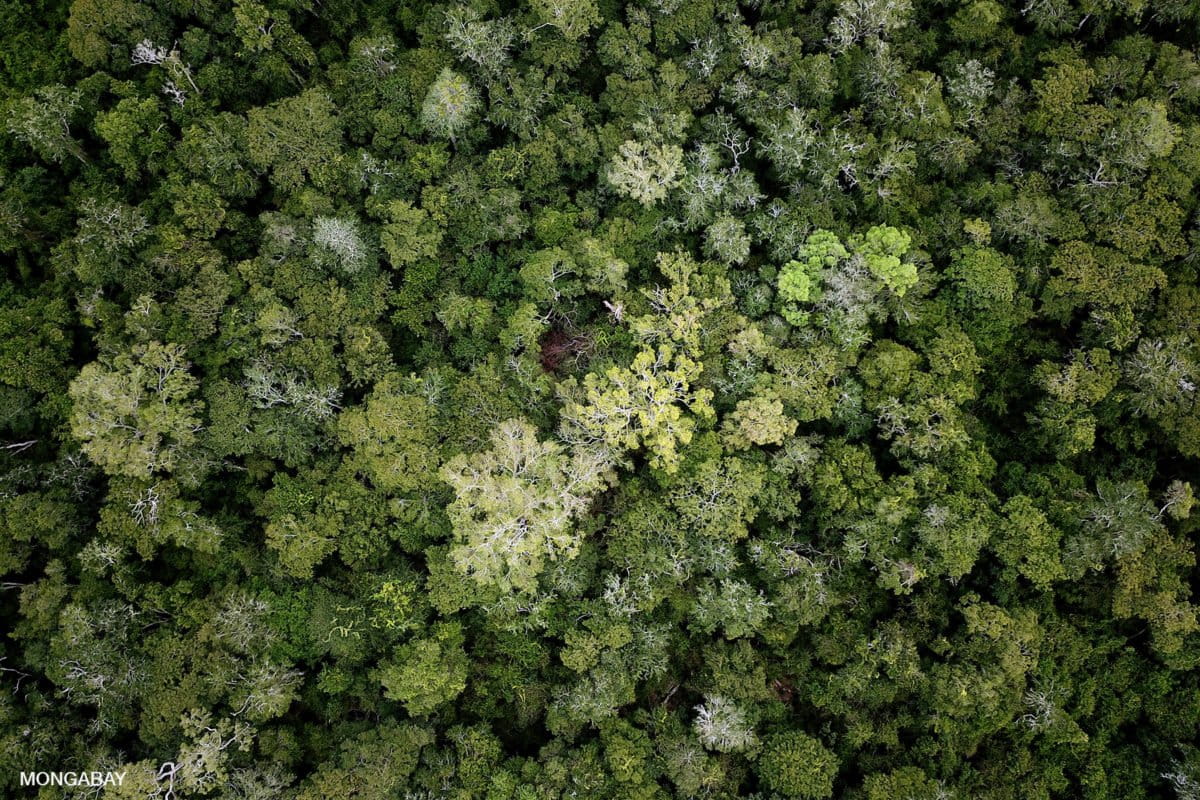
It’s often impossible for us to know how to access and apply to international funding, with endless paperwork in English. We need simple, streamlined systems for financial support with donors coming to us as a group, and helping our civil society in a group, for maximum synergy and efficiency. With special efforts made to include Indigenous people.
Mongabay: How can individuals outside the region become allies of your work?
Gina Méndez: Sign the Forest Pact!
And form alliances to create forest-positive projects together, whether they be through the arts, education, awareness-raising, investigations, mapping, or advocacy.
Mongabay: What advice would you give to someone who is considering a career in conservation?
Gina Méndez: Perseverance is critical. Conservation is a career where you shouldn’t expect immediate results from your work because it takes time for processing like replanting forests, building networks of collaboration, and establishing partnerships. You need deep reservoirs of patience to surmount the relentless delays we often face.
You also need courage in the face of threats, pressure, and lack of resources.
But most of all, you need love. Love for our planet, for animals, and people alike that share our beautiful earth. Only love will power you through the hardest days.

